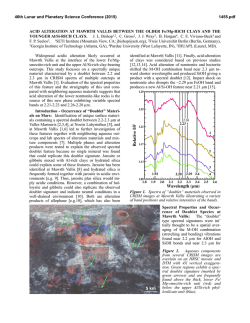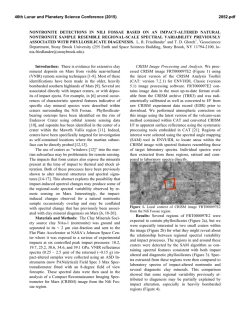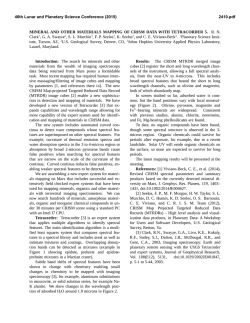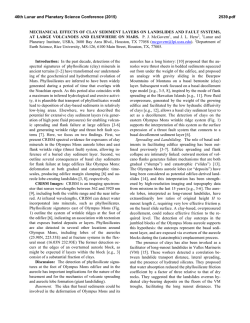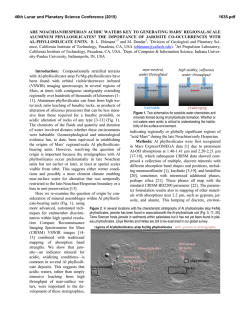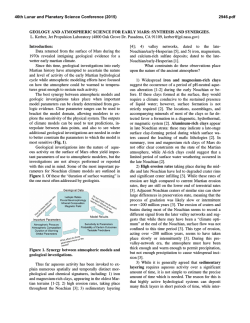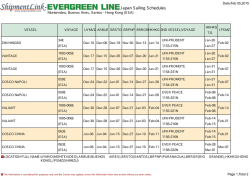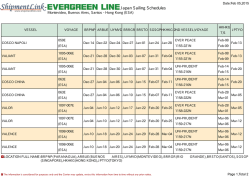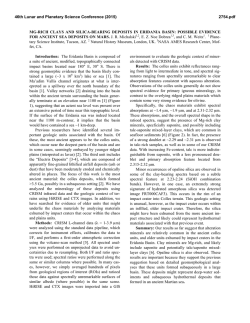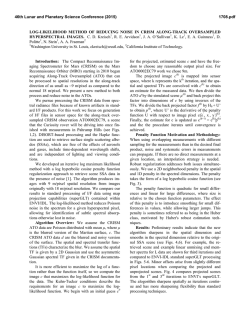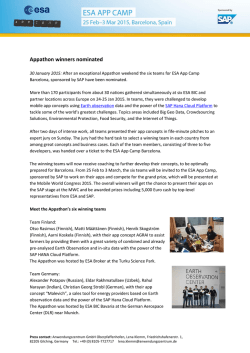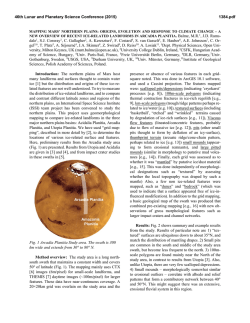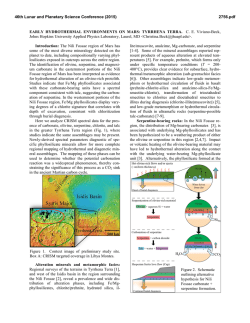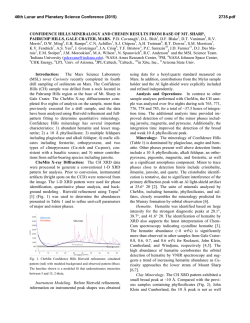
Mineralogic Context of the Circum
46th Lunar and Planetary Science Conference (2015) 1988.pdf MINERALOGIC CONTEXT OF THE CIRCUM-CHRYSE PLANITIA CANDIDATE LANDING SITES FOR THE EXOMARS ROVER MISSION. J. Carter1, D. Loizeau2, C. Quantin2, M. Balme3, F. Poulet1, S. Gupta4, J. L. Vago5, J-P. Bibring1. 1IAS, CNRS/Paris-Sud University, France ([email protected]). 2LGLTPE, Université de Lyon, France, 3DPS, The Open University, Milton Keynes, UK. 4Imperial College London, UK. 5ESAESTEC, The Netherlands. Introduction: The ExoMars rover mission [1] will sample ancient, aqueously altered terrains in order to search for traces of extinct life and to characterize the water history of Early Mars. These objectives translate into site-specific constraints in order to maximize the opportunity to access morphological and/or chemical markers for past aqueous environments and possibly life [2]. The landing site (LS) selection process seeks to achieve the maximum scientific yield for the mission. The wealth of remote sensing data currently available allows highly accurate reconnaissance mapping of the landing ellipses down to the meter to submeter scale. Currently, four candidate landing sites are being considered, all of which are located on the margin of Chryse Planitia (Figure 1): Mawrth Vallis [3], Oxia Planum [4], Aram Dorsum [5] and Hypanis Vallis [6]. The four sites show the presence of hydrous clays, either within the ellipse (up to ~70% coverage at Oxia Planum) or close by (<35 km), suggesting that clays may be present at all locations, although not always observable at the detection limits of orbital instruments (as was the case for the MSL landing ellipse at Gale). Assessing the composition combined with the morphologic/stratigraphic context for these clay deposits is necessary to narrow down possible formation scenarios and to help rank the sites according to their relevance to the science goals. Goals: This work investigates the aqueous mineralogy of the circum-Chyrse region -where the LS are proposed-, in order to provide a framework for future in-depth investigations. Specific questions that will be addressed in this work include: • Are the final four LS representative of what we know of Mars’s early aqueous alteration at a global scale ? • Is there a temporal and spatial connection between the circum-Chryse clay deposits that would imply similar aqueous alteration settings for all LS ? • If not, what is each site’s specificity and implications for the formation mechanisms ? As a first step, the broad aqueous mineralogy of each LS is investigated and then compared to the regional context and to the other LS. Data analysis: Regional mapping of the clay mineralogy was performed using the OMEGA and CRISM NIR imaging spectrometers [7,8]. Global coverage of the circum-Chryse margin was achieved with OMEGA at a spatial sampling ranging ~2-4 km/pix. More detailed mapping was carried out locally with OMEGA and CRISM at ~20-1000 m/pix. Over 60 OMEGA nadir and 160 CRISM multi-spectral (MSP, MSW, HSP) observations were processed, as well as ~30 CRISM high resolution targets at or near each LS. The need for high accuracy in the mapping of the clay deposits precluded the use of pre-mosaicked data products, and required the individual reduction, analysis and mosaicking of each observation, accounting for varying data quality (e.g. SNR, aerosol opacity, H2O clouds). Stringent filters were used to preclude false positives in the mineral maps [9]. A more detailed analysis of the clay chemical composition was carried out by modeling the spectral shape of the Fe/Mg-rich phyllosilicate absorptions in the 2.25-2.35 µm range. An automated linear unmixing algorithm was applied to extract the relative contribution of different phyllosilicate endmembers from high SNR targeted CRISM spectra. Comparison with blind visual inspections provided satisfactory results. Numerous Al-rich clays are identified in the Mawrth Vallis region but not mapped in this study. Preliminary results: Mineral mapping of clays in the circum-Chryse region revealed large exposures of dominantly Fe/Mg-rich phyllosilicates over most of the preserved Noachian-aged margins of Chryse Planitia (Figure 1). These minerals have spectral features that are generally similar to what is found elsewhere on Mars [10]. They are consistent with either mica-group vermiculites but could also be matched by mixedlayered clays with a smectite component [11,12]. Occasionally, hydrous minerals of different composition are detected, but are restricted to specific geological settings, e.g. high temperatures phases (chlorites, serpentines) in D>20 km crater ejecta or hydrated (opalized) silica in Hesperian alluvial fans and plains. A number of similarities in composition and surface morphology have been detected between clay deposits in the Oxia Planum, Hypanis Vallis and possibly Aram Dorsum regions. These similarities and their regional distribution may hint at a common formation setting for most of the non-Mawrth-like clays found circumChryse, in what may be the remnant of an extensive clay-rich horizon spanning an arc of at least 2500 km. A specific regional outlier exists however at and around the Mawrth Vallis LS. The most common clay 46th Lunar and Planetary Science Conference (2015) there is likely Fe-rich nontronite (Figure 2) associated with Al-rich phyllosilicates within layered deposits [13,14], indicating a different alteration setting. This site may however have shared a common aqueous history with the other circum-Chryse clays and then diverged to form more leached clays with Al/Fe rich compositions; alternatively, their detection may be the result of specific mantling/re-surfacing processes. Future work will be carried out to test this hypothesis by investigating the stratigraphy and ages of these deposits, as well as the transitional regions with the Mawrth-like deposits. References: [1] Vago J. et al., 2006, ESA Bulletin, 126, 623 (2006). [2] Call for ExoMars2018 Landing site Proposals, ESA SP. EXM-SCI-LSS-ESA/IKI-001 (2013). [3] Poulet F. et al., ESA ExoMars LSS WS#1 (2014). [4] Quantin C. et al., ESA LSS WS#1 (2014). [5] Balme M. et al., ESA LSS WS#1 (2014). [6] Gupta S. et al., ESA LSS WS#1 (2014). [7] Bibring J-P. et al., ESA SP-1240, 3749 (2004). [8] Murchie S. et al. (2007) JGR, 112, E05S03. [9] Carter J. et al., PSS, 76, 53-67 (2013). [10] Carter J. et al., JGR, 118(4), 831-858 (2013). [11] Milliken R. et al., 42nd LPSC, No 1608, p2230 (2011). [12] Michalski J. et al.., 45th LPSC, No 1777, p1781 (2014). [13] Loizeau D. et al., JGR, 112(E8), E08S08 (2007). [14] Noe Dobrea E. et al., JGR, 115(E11), E00D19 (2010). Figure 2 (right). Fe/Mg phyllosilicate composition in the MawrthOxia region. (a) Absorption band center fitting indicating the presence of Fe-nontronite (≤2.29 µm) or other Fe/Mg clays (>2.30 µm). (b) Relative abundance of Fe/Mg phyllosilicate end-members (larger circles indicate higher abundance). Figure 1 (below). Mineral map of hydrous minerals in the circumChryse region based on OMEGA and CRISM data (red). 1988.pdf
© Copyright 2026
